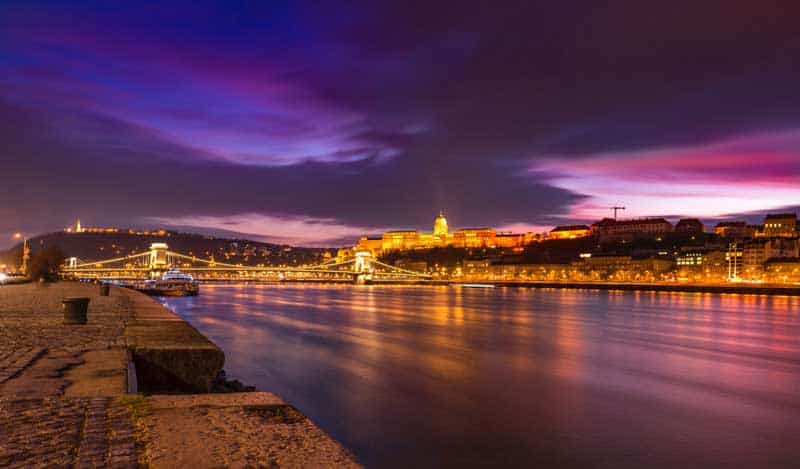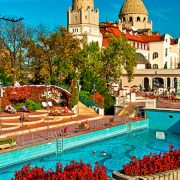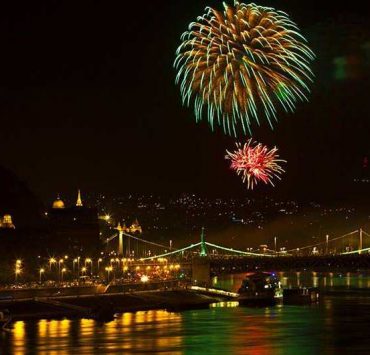Budapest is one of the most beautiful cities in the world. That it has developed where it is, is not down to some historical accident. Take a look at Gellért Hill, right next to the River Danube as it flows majestically through the centre of the modern city.
It was precisely the combination of the relative ease of crossing the River here and the natural protection the hill offered against invasion that persuaded the earliest settlers it was the ideal place to build a town.
BUDAPEST OVERVIEW
BUDAPEST’S DISTRICTS AND SURROUNDINGS
BUDA SIDE AND PEST SIDE
WHICH AREA TO CHOOSE?
BUDAPEST OVERVIEW
There are plenty of other capital cities built on the banks of a river, and in many cases the river runs through the historic centre. But such a wide and majestic river, as is the Danube at Budapest, is more of a rarity. Even more exceptional is the perfect contrast between the right and left banks. Buda is built upon hills, the feet of two of them – Castle Hill and Gellért Hill – almost stand in the water. Facing it is Pest, lacking the hills of its sister and generally considered to include downtown Budapest.
A bejegyzés megtekintése az Instagramon
Several UNESCO World Heritage Sites
It’s no exaggeration to say that Budapest is one of the finest capital cities in Europe, and also one of the best situated. Among the several places in Hungary that have been afforded the classification of UNESCO World Heritage Site, the first were the Danube panorama (on the Buda side from the Gellért Hotel all along Castle Hill to Margit Bridge, and on the Pest side from the Parliament back down to Petőfi Bridge), and Andrássy út (along its entire length from the centre of Pest to Hősök tere, where the Millenary Monument stands on the edge of the City Park).
A bejegyzés megtekintése az Instagramon
At the time of the Magyar Conquest in 896, the first Hungarian tribes settled in the plains to the east. They migrated to the hills further west later on to take advantage of the greater protection they offered. Buda became the royal seat in the thirteenth century and saw the court’s rising status reflected in the building of ever more splendid palaces and the expansion of the town into a flowering middle class town. Pest at this time was a town of merchants and artisans.
A bejegyzés megtekintése az Instagramon
1873 was a milestone in the history of Budapest, as it was in this year that the three separate settlements of Pest, Buda and Óbuda (literally Old Buda) were united. The newly coined “Budapest” was named the official capital city of Hungary and underwent an unprecedented growth in size, wealth, and development. But this wasn’t just a golden period for the city; it coincided with the millennial celebrations of 1896, marking 1,000 years of the Magyar state.
Read about Hungarian culture and traditions!
Budapest, now home to approximately two million inhabitants, would ap- pear countless times on any list of superlatives. Innovation and invention have coloured Hungarian history: the father of the electric railway, Kálmán Kandó, lived here (it should be no surprise, then, that the first underground railway in mainland Europe was also built here), and János Irinyi, one of the early developers of safety matches built a factory here in 1840.
A bejegyzés megtekintése az Instagramon
Pioneering forces in Hollywood, from legendary actresses to celebrated film makers, listed Budapest as their hometown, while today it is used as a backdrop for many movies. Two of Hungary’s most celebrated composers, Béla Bartók and Zoltán Kodály, lived in Budapest, and Nobel Prize-winning Hungarian author Imre Kertész was born here. Pál Erdős, arguably one of the world’s most prominent mathematicians, was born here as well.
Click here for famous Hungarians womanizers from the past!
Hungary’s oldest academic library, the University Library, can be found in Budapest, as can Europe’s largest synagogue. It is the only capital city in the world where there are more than 100 hot thermal springs. There is no city of comparable size anywhere in the world where visitors can explore dripstone (stalactite) caves in the middle of a residential district. It would also be difficult to find another city where visitors are faced with such a choice in their transport! From buses, trams, and trolleybuses, to trains, metros, cogwheel, funicular, and forest railways, from horse-and-traps, chair-lifts, cars, and boats, to bicycles, and, on Margit Sziget, the “bringóhintó” family cycle cars, Budapest has them all! Let’s choose one, and set off along the World Heritage streets.
A bejegyzés megtekintése az Instagramon
BUDAPEST’S DISTRICTS AND SURROUNDINGS
As this guide illustrates, Budapest has 23 different districts. Districts V and VI are considered the city centre and boast a plethora of offices, banks, restaurants, pubs, shops, and hotels. These districts are also home to the two most famous streets in Budapest, with Andrássy út running through the length of District VI and the legendary Váci utca shopping street in the heart of District V. With these, Districts VII, VIII, IX and inner XIII are considered to be the downtown area.
A bejegyzés megtekintése az Instagramon
Here you will find nice properties for rent – both traditional and modern houses – as well as a wealth of shops, clubs, restaurants, and theatres. These districts are recommended for those expats who want to enjoy nightlife: be it seeing an opera or grabbing a nightcap. Here you are in the beating heart of the city, surrounded by liveliness. Districts X, outer XIII, XIV, XV, XVI, XVII, XVIIII, XIX, XX, XXI, XXIII, and IV are mainly mixed industrial and residential areas. There are lots of housing estates, industrial parks, and factories located here. These districts will put one at relative ease for accessing Budapest Airport.
Here’s our ultimate public transport guide, so no matter where you live, you can get to the city with ease.
BUDA SIDE AND PEST SIDE
The Buda districts are quite different from those in the Pest area, as Buda is hilly and green compared to the flat and more developed Pest.
District I and the lower half of District II are considered to be the centre of Buda. Here one can find the Buda Castle, Mammut shopping mall (home to bowling!), and the main road junction and public transport meeting point at Széll Kálmán tér. Districts XII, II, II/A Hűvösvölgy, Adyliget and Hidegkút) and XI and III are mainly residential areas, meaning they are generally quiet and safe.
Click for our guide that will take you from Moszkva tér to Margaret Bridge!
Beautiful homes and renovated apartments are for rent along their leafy side streets and the majority of the international schools and kindergartens are located in this area. These districts are recommended for expats with families and those who want a quieter life!
A bejegyzés megtekintése az Instagramon
As Budapest has grown, so too have its suburbs and the surrounding towns and villages. There are many new condominiums and houses being built in these burgeoning settlements. Travelling into Budapest is not difficult, nor does it take too long; however, the rush hours do lengthen the trip. The most popular commuter towns around Budapest are Szent- endre, Pilisvörösvár, Üröm, Solymár, Nagykovácsi, Törökbálint, Budaörs, Diósd, Budakeszi, Páty, Telki, Szigetszentmiklós, Dunakeszi and Gödöllő. Even if you do not live in one of them, many are worth a visit!
WHICH AREA TO CHOOSE?
Both Budapest and the surrounding areas are constantly changing – districts and villages, which might not have been very residential some years back have been renovated and become more popular. If you like a particular property, but are unsure about the area or would like to ask further questions about its location, please share your concerns with your relocation consultant, and they will offer you objective advice.
The following points tend to be the most considered when deciding on a particular area:
- Proximity to particular schools, kindergartens or nurseries
- Distance and time it takes to travel to work taking into consideration the traffic problems
- Availability of public transport
- Shopping facilities, hypermarkets, supermarkets, etc.
- Access to motorways and the airport
- Parking
- Is it in an “expatriate area”, with proximity to other expats
- Proximity of parks, cultural activities, restaurants, and sporting facilities




